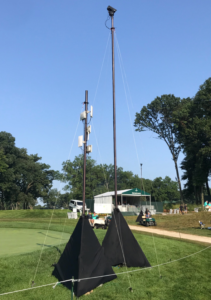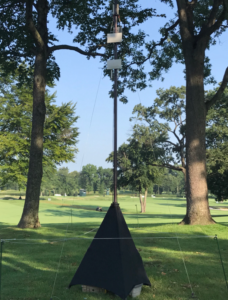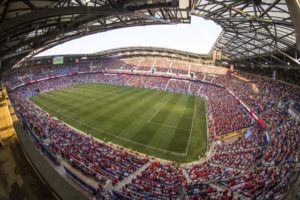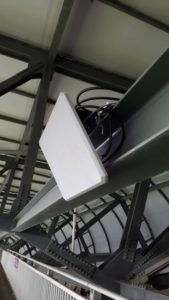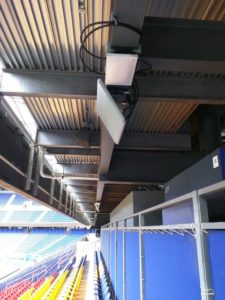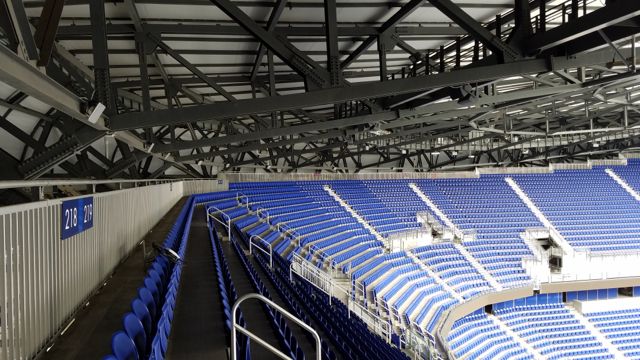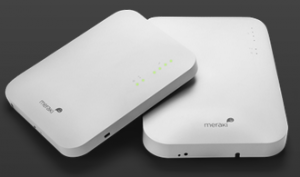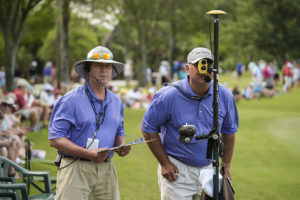
Volunteers track shots with lasers on the fairways of PGA Tour tournaments. Credit: Chris Condon/PGA TOUR (click on any photo for a larger image)
A recent 14-state test run by the top professional U.S. golf tour tapped the newly designated Citizens Broadband Radio Service (CBRS), which comprises 150 MHz of spectrum in the 3.5 GHz band. Golf courses, which typically lack the dense wireless coverage of more populated urban areas, are easily maxed out when thousands of fans show up on a sunny weekend to trail top-ranked players like Brooks Koepka, Rory McIlroy or perennial favorite Tiger Woods.
To cover the bandwidth needs of tournaments, the PGA Tour has over time used a mix of technologies, many portable in nature given the short stay of a tournament at any given course. Like Wi-Fi or temporary cellular infrastructures used in the past, the hope is that CBRS will help support public safety, scoring and broadcast applications required to keep its events operating smoothly and safely, according to the PGA Tour.
“We’re looking at replacing our 5 GHz Wi-Fi solution with CBRS so we can have more control over service levels,” said Steve Evans, senior vice president of information systems for the PGA Tour. Unlike 5 GHz Wi-Fi, CBRS is licensed spectrum and less prone to interference the Tour occasionally experienced.
CBRS will also make a big difference with the Tour’s ShotLink system, a wireless data collection system used by the PGA Tour that gathers data on every shot made during competition play – distance, speed and other scoring data.
“CBRS would help us get the data off the golf course faster” than Wi-Fi can, Evans explained. “And after more than 15 months of testing we’ve done so far, CBRS has better coverage per access point than Wi-Fi.”
The preliminary results are so encouraging that the Tour is also looking to CBRS to carry some of its own voice traffic and has already done some testing there. “We need to have voice outside the field of play, and we think CBRS can help solve that problem,” Evans added.
But as an emerging technology, it’s important to acknowledge the limitations of CBRS. Compatible handsets aren’t widely available; the PGA Tour has been testing CBRS prototypes from Essential. Those units only operate in CBRS bands 42 and 43; a third, band 48, is expected to be added by device makers sometime in the first half of 2019.
“We’re waiting for the phones to include band 48 and then we’ll test several,” Evans told Mobile Sports Report. “I expect Android would move first and be very aggressive with it.”
The PGA Tour isn’t the only sports entity looking at CBRS’s potential. The National Football League is testing coach-to-coach and coach-to-player communications over CBRS at all the league’s stadiums; the NBA’s SacramentoKings are testing it at Golden 1 Center with Ruckus; NASCAR has been testing video transmission from inside cars using CBRS along with Nokia and Google, and the ISM Raceway in Phoenix, Ariz., recently launched a live CBRS network that it is currently using for backhaul to remote parking lot Wi-Fi hotspots.
Outside of sports and entertainment, FedEx, the Port of Los Angeles and General Electric are jointly testing CBRS in Southern California. Love Field Airport in Dallas is working with Boingo and Ruckus in a CBRS trial; service provider Pavlov Media is testing CBRS near the University of Illinois Champaign-Urbana with Ruckus gear. Multiple service providers from telecom, cable and wireless are also testing the emerging technology’s potential all around the country.
Where CBRS came from, where it’s going
Editor’s note: This profile is from our latest STADIUM TECH REPORT, an in-depth look at successful deployments of stadium technology. Included with this report is a profile of the new game-day digital fan engagement strategy at Texas A&M, as well as a profile of Wi-Fi at Merceds-Benz Stadium, home of Super Bowl LIII in Atlanta! DOWNLOAD YOUR FREE COPY now!
CBRS has undergone a 6-year gestation period; 150 MHz worth of bandwidth was culled from the 3.5 GHz spectrum, which must be shared (and not interfere) with U.S. government radar operations already operating in that same spectrum.
From a regulatory perspective, CBRS’s experimental status is expected to give way to full commercial availability in the near future. Consequently, wireless equipment vendors have been busy building – and marketing – CBRS access points and antennas for test and commercial usage. But entities like the PGA Tour have already identified the benefits and aren’t waiting for the FCC to confer full commercial status on the emerging wireless technology.
CBRS equipment vendors and would-be service providers were hard to miss at last fall’s Mobile World
Congress Americas meeting in Los Angeles. More than 20 organizations – all part of the CBRS Alliance – exhibited their trademarked OnGo services, equipment and software in a day-long showcase event. (Editor’s note: “OnGo” is the alliance’s attempt to “brand” the service as something more marketable than the geeky CBRS acronym).
The CBRS Alliance envisions five potential use cases of the technology, according to Dave Wright, alliance president and director of regulatory affairs and network standards at Ruckus:
• Mobile operators that want to augment capacity of their existing spectrum
• Cable operators looking to expand into wireless services instead of paying a mobile virtual network operator (MVNO)
• Other third-party providers looking to offer fixed broadband services
• Enterprise and industrial applications: extending or amplifying wireless in business parks and remote locations; Internet of Things data acquisition.
• Neutral host capabilities, which some have likened to LTE roaming, an important development as 5G cellular services ramp up.
Previously, if customers wanted to extend cell coverage inside a building or a stadium, their best option was often distributed antenna systems (DAS). But DAS is complicated, expensive and relies on carrier participation, according to Wright. “Carriers also want to make sure your use of their spectrum doesn’t interfere with their macro spectrum nearby,” he added.
CBRS uses discrete spectrum not owned by a mobile operator, allowing an NFL franchise, for example, to buy CBRS radios and deploy them around the stadium, exclusively or shared, depending on their requirements and budgets.
On a neutral host network, a mobile device would query the LTE network to see which operations are supported. The device would then exchange credentials with the mobile carriers – CBRS and cellular – then permissions are granted, the user is authenticated, and their usage info gets passed back to the carrier, Wright explained.With the PGA Tour tests, the Essential CBRS devices get provisioned on the network, then connect to the CBRS network just like a cell phone connects to public LTE, Evans explained. The Tour’s custom apps send collected data back to the Tour’s network via the CBRS access point, which is connected to temporary fiber the Tour installs. And while some of Ruckus’s CBRS access points also support Wi-Fi, the Tour uses only the CBRS. “When we’re testing, we’re not turning Wi-Fi on if it’s there,” Evans clarified.
While the idea of “private LTE” networks supported by CBRS is gaining lots of headline time, current deployments would require a new SIM card for any devices wanting to use the private CBRS network, something that may slow down deployments until programmable SIM cards move from good idea to reality. But CBRS networks could also be used for local backhaul, using Wi-Fi to connect to client devices, a tactic currently being used at ISM Raceway in Phoenix.
“It’s an exciting time… CBRS really opens up a lot of new opportunities,” Wright added. “The PGA Tour and NFL applications really address some unmet needs.”
CBRS on the Fairways
Prior to deploying CBRS access points at a location, the PGA Tour surveys the tournament course to create a digital image of every hole, along with other data to calculate exact locations and distances between any two coordinates, like the tee box and the player’s first shot or the shot location and the location of the hole. The survey also helps the Tour decide how and where to place APs on the course.
Courses tend to be designed in two different ways, according to the PGA Tour’s Evans. With some courses, the majority number of holes are adjacent to each other and create a more compact course; other courses are routed through neighborhoods and may snake around, end-to-end.
“In the adjacent model, which is 70 percent of the courses we play, we can usually cover the property with about 10 access points,” Evans explained.
Adjacent-style courses where the PGA Tour has tested CBRS include Ridgewood Country Club in Paramus, N.J.; Aronimink Golf Club in Newtown Square, Penn.; and East Lake Golf Club in Atlanta.
In the second model, where the holes are strung back to back, the PGA Tour may have to deploy as many as 18 or 20 APs to get the coverage and throughput it needs. That’s the configuration used during a recent tournament at the TPC Summerlin course in Las Vegas, Nev., Evans told Mobile Sports Report.
On the course, CBRS APs get attached to some kind of structure where possible, Evans added. “Where that doesn’t make sense, we have portable masts we use – a tripod with a pole that goes up 20 feet,” he said. The only reason he’d relocate an AP once a tournament began is if it caused a problem with the competition or fan egress. “We’re pretty skilled at avoiding those issues,” he said.
A handful of PGA Tour employees operates its ShotLink system, which also relies on an army of volunteers – as many as 350 at each tournament – who help with data collection and score updates (that leader board doesn’t refresh itself!). “There’s a walker with each group, recording data about each shot. There’s technology for us on each fairway and green, and even in the ball itself, as the ball hits the green and as player hits putts,” said Evans.
The walker-volunteers relay their data back to a central repository; from there, ShotLink data then gets sent to PGA Tour management and is picked up by a variety of organizations from onsite TV broadcast partners; the pgatour.com Website; players, coaches and caddies; print media; and mobile devices.
In addition to pushing PGA Tour voice traffic over on to CBRS, the organization is also looking for the technology to handle broadcast video. “We think broadcast video capture could become a [CBRS] feature,” Evans said. The current transport method, UHF video, is a low-latency way to get video back to a truck where it can be uploaded for broadcast audiences.
A broadcast program produced by the organization, PGA Tour Live, follows two groups on the course; each group has four cameras and producers cut between each group and each camera. That video needs to be low latency, high reliability, but is expensive due to UHF transmission.
Once 5G standards are created for video capture, the PGA Tour could use public LTE to bond a number of cell signals together. Unfortunately, that method has higher latency. “It’s fine for replay but not for live production,” Evans said, but is expected to eventually improve performance-wise. “The idea is eventually to move to outside cameras with CBRS and then use [CBRS] for data collection too,” he added. “If we could take out the UHF cost, it would be significant for us.”
In the meantime, the Tour will continue to rely largely on Cisco-Meraki Wi-Fi and use Wi-Fi as an alternate route if something happens to CBRS, Evans said. “But we expect CBRS to be primary and used 99 percent of the time.”
